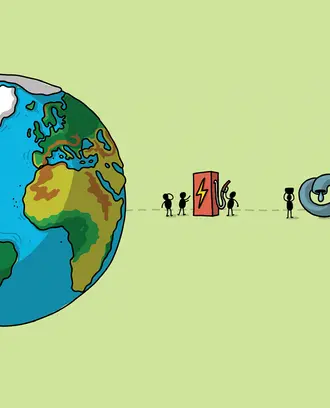Credit: iStock.com/felixmizioznikov
Climate change’s devastating environmental effects are well-documented: rising temperatures, droughts, altered ecosystems and agricultural supply, melting glaciers.
It also affects real estate markets, in the form of climate gentrification. The concept was explored last year in research from Harvard University, showing that the rate of price appreciation of single family homes in Miami increases with elevation. As as developers snap up property in newly desirable areas that are less vulnerable to sea level rise, they will likely drive up prices and displace longtime residents.
In Miami, lower-income residents tend to live in high-elevation areas, while waterfront property is prime. But as tides rise and waterfront homes are compromised, long-forgotten areas have become a hot commodity.
In February, the Sustainability Initiative at MIT Sloan leadership team, along with 15 advisory board members, traveled there for a weekend retreat. They spent the day with activists from Little Haiti, one of the city’s fastest gentrifying areas. On an afternoon trip to the Everglades, they learned firsthand about climate-driven inequality.
“We hoped that by bringing members of our advisory board — mostly Sloan and MIT graduates and now leaders in business, real estate, investing, and policy — to the issue, we could raise awareness and possibly spark action for change. I would describe it as eye-opening, discomforting at times, hopeful, and passionate,” said sustainability initiative lecturer and senior associate director Bethany Patten, EMBA ’13.
Here’s what concerned leaders can do about the issue.
Pay a fair wage. “Entrepreneurs can play an important role in the creation of a more resilient workforce. They can start by creating businesses that are conduits for community wealth building, like co-ops, and make sure to pay their employees at least $15 or higher, depending on the cost of living of their city. Having a workforce that’s economically secure ensures that they are more resilient to shocks like climate disasters and more likely to be active in efforts to curb CO2 emissions, since their basic needs are being met,” said Adrian Madriz, project lead at Struggle for Miami’s Affordable and Sustainable Housing.
Appreciate gentrification’s domino effect. “In a country where the wealth inequality divide is getting worse, we have to pay attention to things that make this divide worsen. … Climate change is a threat accelerator. It acts upon existing social issues by accelerating its effect, because it adds stressors to our systems and environments,” said sustainability certificate graduate Linda Cheung, MBA ’17, who helped to organize the event. Cheung founded nonprofit Before It’s Too Late, a prototyping lab that uses art and technology, such as augmented reality murals, to engage the public on climate change.
“Those who are left behind will erode the overall community's health. Investors and developers who want to create healthy communities have to be aware of climate justice issues, such as climate gentrification. Realize that ESGs [environmental, social, and governance] are important, not just shareholder profits. Corporations may also have a fiduciary duty to creating prosperous, resilient, and sustainable communities,” she said.
Factor climate into future planning — because investors might demand it. Climate gentrification affects any business whose physical operations could be altered by climate change, Patten said.
“Along with mitigation strategies, which seek to reduce an organization’s impact on the environment, adaptation strategies are essential if an organization wants to continue to operate. For some, this might mean making changes inside their four walls, such as putting HVAC on the roof; for others, it might mean moving physical operations to areas of less risk,” she said.
It could also become part of more formal, institutionalized regulations and reporting requirements.
“Bloomberg’s Task Force on Climate-Related Financial Disclosures, while voluntary, calls for organizations to develop consistent climate-related financial risk disclosures to provide information to investors, lenders, insurers, and other stakeholders. The task force ‘will consider the physical, liability, and transition risks associated with climate change and what constitutes effective financial disclosures across industries.’ What this means is that investors will start to demand more disclosure on the risks of climate change to an organization and demand that organizations respond to that risk if they want to stay in business,” Patten said.
Think about mutually beneficial co-existence when moving to a new neighborhood. “Any time a development is proposed in a low-income and gentrifying neighborhood, these kinds of projects should be willing and enthusiastic to engage with local residents on how the project can meet its business goals while also protecting and enhancing the lives of local residents,” Madriz said. “The backlash that Amazon has received for HQ2 is a good example of how not to do that, while the community benefits agreement that the Obama Presidential Center in Chicago will be subjected to presents a great model on how to move forward.”
Are you a leader confronting or considering solutions to climate gentrification and related challenges? The MIT Sloan Sustainability Initiative wants to hear your story. Share it on Twitter by tagging and following @mitsloansusty and #climategentrification to join our community of leaders taking action.



